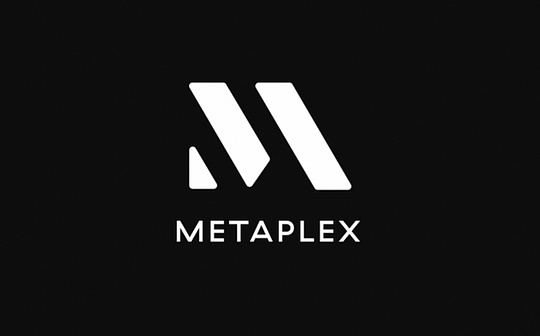
Author: Alex Xu, Mint Ventures
1. Introduction
If you want to talk about which L1 is the best business development in this bull cycle, most people’s answer will be: Solana.
Whether it is the number of active addresses or the fee income, Solana’s market share in L1 has expanded rapidly:
Number of active addresses: Solana’s share of active addresses increased from 3.48% to 56.83%, a year-on-year increase of 1533%;
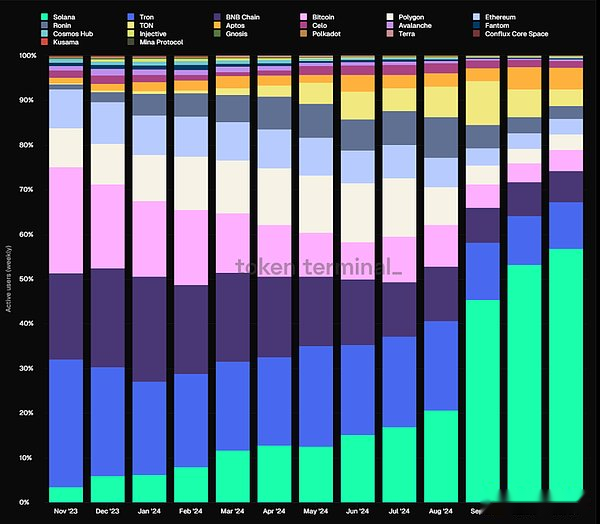
L1 monthly active addresses market share, data source: tokenterminal
Fee: Solana’s Fee revenue share grew from 0.62% to 28.92%, up 4564% year-on-year.
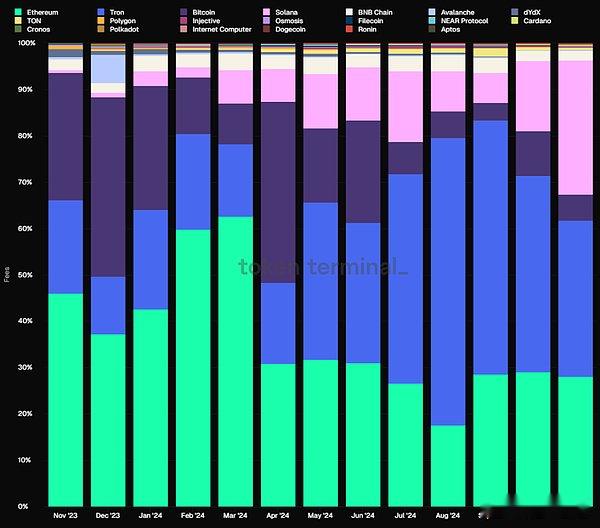
L1 monthly Fee revenue market share, data source: tokenterminal
Meme Inspur is the core driving force for the rapid growth of various core indicators during Solana’s cycle. In addition to Solana, Dex like Raydium also benefits from Meme Inspur. The active Meme trading contributes huge transactions and agreements to it.Revenue, its price has also reached a new high in this round recently.
In this article, the author will focus on another project that benefits from the huge amount of assets issued by Solana: @metaplex.
This article will present and discuss the following 4 issues:
-
What is Metaplex’s business positioning and business model?Does it have a moat?
-
How is Metaplex’s business data and how is the business development?
-
Metaplex’s team background and financing status, how to evaluate the project team?
-
What is the current valuation level of Metaplex? Is there any safety margin?
This article is the author’s phased thinking as of the time of publication. It may change in the future, and its views are highly subjective, and there may be errors in facts, data, and reasoning logic. Criticism and further discussions from peers and readers are welcome, but this article does notConstitute any investment advice.
The following is the main text part.
2. Metaplex’s business positioning and business model
The Metaplex protocol is a digital asset creation, sales and management system built on Solana and on blockchains that support SVMs (Solana Virtual Machines). It provides developers, creators and enterprises with tools to build decentralized applications andstandard.The types of crypto assets supported by Metaplex include NFT, FT (homogeneous tokens), real-world assets (RWA), game assets, DePIN assets, etc.
Metaplex has also expanded its business horizontally to other basic service areas of the Solana ecosystem, such as data indexing (Index) and data availability (DA) services.
In the long run, Metaplex is expected to become one of the most important multi-field basic service projects in the Solana ecosystem.
2.1 Metaplex’s product matrix
As an asset issuance, management and standards system, Metaplex serves both NFT and homogeneous tokens. The products listed below form a comprehensive matrix serving Solana’s ecological assets.
Core
Core is the new generation of NFT standard on the Solana blockchain. Core adopts a “single account design”, which significantly reduces casting costs and computing power, and supports advanced plug-ins and mandatory royalties.
Background: Solana’s Account Model
In order to understand the advantages of the “single account design” architecture, we need to first understand the account model of Solana blockchain and the storage method of traditional NFTs.
On the Solana blockchain, all state storage (such as token balances, NFT metadata, etc.) are associated with a specific account.Each account can store a certain amount of data, and the size of the account is limited and rent is required to maintain the storage of this data.Therefore, how to efficiently manage accounts and store data on the chain is a key issue that developers on Solana need to consider.
Traditional NFT design
In traditional NFT designs, usually each NFT will have multiple accounts to store different information.For example, a typical NFT might involve several accounts:
Master Account: Stores ownership information of the NFT (such as who is the current holder).
Metadata Account: Stores metadata of NFTs (such as name, description, image link, etc.).
Royalties Account: Stores information related to creator royalties.
Although this multi-account design is relatively flexible, it will cause some problems in actual operation:
Complexity: Management and interactions of multiple accounts add complexity, especially when frequent queries and updates of data are required.
Fees: Each account needs to pay rent to maintain its storage status, and more accounts mean higher fees.
Performance: Since multiple accounts are involved, more blockchain resources may be required when operating, affecting performance and transaction speed.
Advantages of “Single Account Design”
Metaplex Core proposed the standard for “single account design” in response to the above issues. Single account design stores all NFT-related information (such as ownership, metadata, royalties, etc.) in one account, which simplifies the account structure and reduces theIt improves account cost, improves interaction efficiency, and enhances the scalability of NFT.This design is particularly suitable for implementing large-scale NFT projects (such as games, Depin, etc.) on high-performance, low-cost blockchains like Solana.
Bubblegum
Bubblegum is a program used by Metaplex to create and manage compressed NFTs (cNFTs).Through compression technology, creators can cast large amounts of NFTs at extremely low cost, and the casting cost of 100 million NFTs is only 500 SOL (more than traditional casting methods achieve cost reduction of more than 99%), providing unprecedented scalability andFlexibility is also possible due to the launch of Bubblegum technology, and large-scale low-cost NFT casting, which has begun to migrate to Solana, which has also given birth to an innovative NFT platform like DRiP. The following table is hereThree representatives list of examples of application to Bubblegum.

Token Metadata (token metadata)
The Token Metadata program allows additional data to homogenized and non-homogenized assets on Solana.Token Metadata is naturally important for information-rich NFTs, but in fact, most of the homogeneous token projects on Solana also require Token Metadata.
What most people don’t know is that the largest Meme issuing platform on Solana, all tokens created on Pump.fun rely on Metaplex’s metadata service. Now the biggest demand for Token Metadata is no longer from NFT, but fromMassively issued Meme projects.
For Meme projects, the benefits of using the Token Metadata program when issuing tokens are very obvious:
-
The first is to ensure the standardization and compatibility of its issuance tokens.Using Metaplex’s Metadata service, these tokens will be more easily correctly identified by mainstream wallets (such as Phantom, Solflare), and are more likely to be correctly displayed by trading platforms, as well as by other Solana applicationsSeam integration.
-
The second is to provide on-chain storage and transparency.The Metaplex Metadata service stores the token’s metadata on the chain, making the token’s information and data easier to verify and prevents tampering.
-
The additional additional information of the picture text provides multi-dimensional material for Meme’s speculation, making meme no longer a name and a string of contracts, and providing material for Meme’s dissemination, creation and narrative.

New Meme tokens that are constantly refreshing on pump.fun, source: pump.fun
As the Meme craze on Solana continues to heat up, more than 90% of Metaplex’s protocol revenue has long been contributed by homogeneous tokens (Meme). This actual situation is related to the public’s understanding of “Metaplex is a Solana ecosystem’s NFT basic protocol.”Inconsistent, there is serious cognitive gap.
Candy Machine
Metaplex’s Candy Machine is the most commonly used NFT casting and distribution program on Solana, enabling efficient, fair and transparent launch of NFT collections.
Other product arrays
Other Metaplex services include:
-
MPL-Hybrid: Hybrid NFT storage and management solutions designed to combine the advantages of on-chain and off-chain storage to provide NFTs with efficient and economical storage, especially suitable for storing large files (such as high resolution), or requiringDynamically updated NFT projects.
-
Fusion: NFT merging function allows users to merge multiple NFTs into a new NFT, which can be used to enhance the user’s interactive experience and provide more gameplay for NFT projects, which can be used for games, collections, and art projects.
-
Hydra: Efficient, scalable, large-scale NFT casting solution designed specifically for projects that need to cast large amounts of NFTs, such as games, social platforms, or loyalty programs.
-
…
Metaplex’s existing product list (asset service category) is as follows:
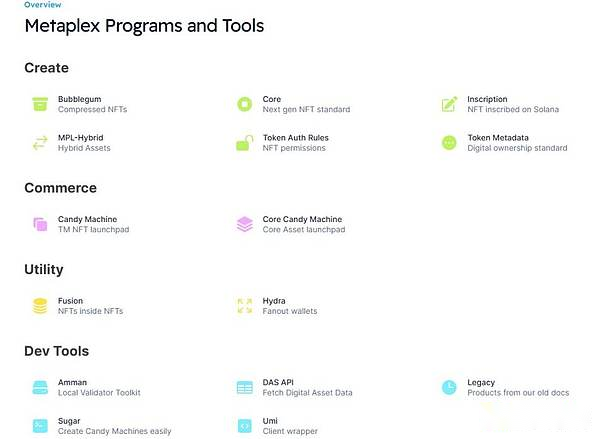
Image source: Metaplex Developer Documentation
Aura
In addition, in September, the Metaplex Foundation officially announced the launch of Metaplex Aura, a decentralized indexing and data availability network for Solana and SVM services (test network).Through the index and data availability services provided by Aura, Solana and other blockchain projects with SVM standards can read asset data more efficiently, support batch operations at lower costs, reducing the cost of their operations by more than 99%., as shown below:
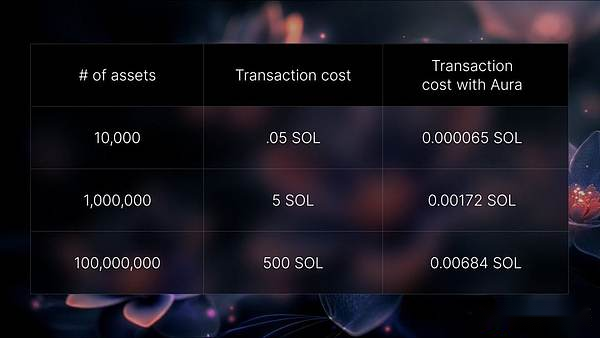
After adopting Aura, compare the costs of large-scale asset assets before and after operation, source: Metaplex official recommendation
When the product preview was released, Metaplex also listed cooperation agreements to support the product. Many of them are well-known projects in the Solana ecosystem, and they will also be potential users of Aura in the future.
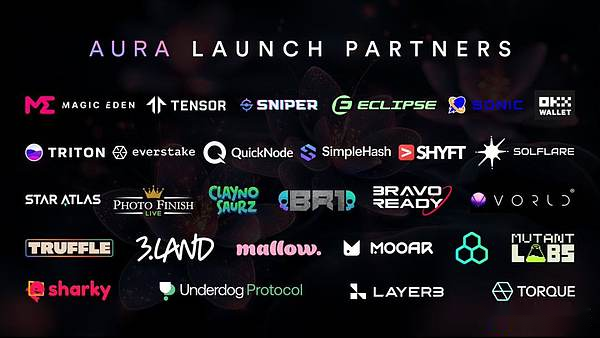
Source: Metaplex Official Recommendation
From asset service systems to data indexing and data availability service agreements, with the horizontal expansion of services, Metaplex is developing into a full-stack basic service platform of the Solana ecosystem.
2.2 Metaplex’s business model
Metaplex’s business model is simple and easy to understand, that is, it charges by providing on-chain asset-related services. Some services in the product array mentioned above are free and some are charged.
Although Metaplex’s direct partner is other projects on Solana, like a TOB expansion business, most of its fees come from small projects or retail users using B-side large projects, including creating various homogeneous generations.The project party of the coin, and the individual users of Mint NFT.
In my opinion, charging dispersed users is a better business model compared to charging large-scale cooperative projects on the B-side (such as Pump.fun), charging dispersed users is a better business model because:
-
Small project users or retail users make decisions more emotional and are not as sensitive to price than B-side, because Metaplex’s service price accounts for a very low proportion of the total cost of spending, and the absolute cost paid by each small userNot high, but the total cost is considerable when the quantity is large enough
-
B-end projects can become the distribution channel for their services, helping Metaplex’s services reach more distributed users. Metaplex itself does not need to spend extra energy and costs on marketing and channels.
-
The user group is more scattered and has a low concentration. Faced with the high difficulty of bargaining for basic service providers like Metaplex, Metaplex has the ability to maintain the profit margin of the product and even raise prices at the appropriate time.
Specifically, Metaplex products charge for Solana as follows:
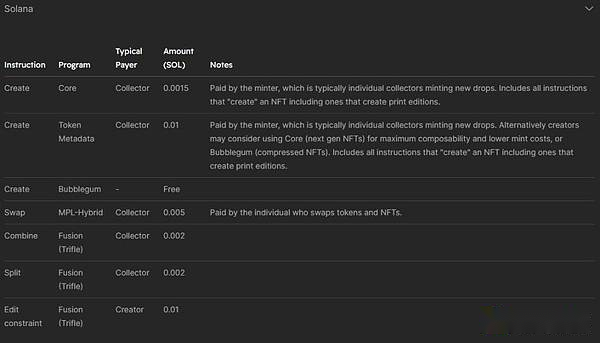
Image source: Metaplex Developer Documentation
It can be seen that in fact, the absolute charge for users to call Metaplex’s product services is not expensive. For example, the NFT fee of users Mint is only 0.0015 SOL; a Meme issuer issues a project to add a picture to their Meme project.Token Metadata is used for information such as article introduction, and only 0.01 Sol is required at a time.Such costs are minimal or basically negligible relative to user’s revenue expectations.
Of course, what needs to be explained is that the large number of homogeneous tokens represented by Meme have brought income to Metaplex on the one hand, and on the other hand, the sustainability of the Meme boom is questionable, which will also affect the availability of Metaplex’s revenueContinuity.As strong as Solana, the popularity of its Meme is also quite volatile. In the coldest September week, the number of new tokens on Dex is only about 1/3 of the hottest in May, and this is in mid-November.The number has increased by 10 times.
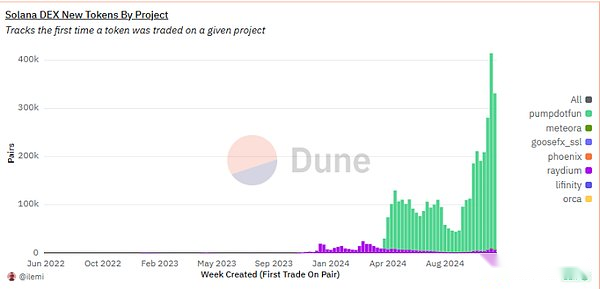
Solana Dex The number of new token varieties added every week, source: Dune
2.3 Metaplex’s moat
In the business world, an enterprise\project’s moat may come from many advantages, such as cost advantages brought by scale and geographical location, value accumulation brought by network effects, and high user stickiness and premium capabilities brought by brand effects., competitive barriers brought by administrative franchise and patents, etc.
Projects with strong moats are reflected in the competitive landscape as later competitors find it difficult to catch up when they enter the same track, or the overall cost of catching up is very high, so high that it is much greater than their expected returns, so that the track’sThere are relatively few competitors; financially reflected in the project’s profitability is steady and gradual increase, and the cost of marketing and development accounts for a low proportion of revenue.
In the Web3 field, there are not many projects with strong moats, such as Tether in the stablecoin field and Aave in the centralized lending field.
In my opinion, Metaplex is also a project with a moat, and its moat comes from “high conversion costs” and “setting standards”.
First, when developers and users rely deeply on Metaplex’s tools and protocols for asset issuance and management, and if they want to switch the project’s assets to other protocols for management in the future, they will inevitably face higher time, technical and economic costs.
Second, when Metaplex’s asset format (including NFT and FT) becomes a common standard in the Solana ecosystem and a consensus on compatible design of various infrastructure and applications within the ecosystem, it will also become a new developer and project to select assets.When serving the platform, priority is given to the Metaplex asset format with stronger ecological compatibility.
Thanks to Metaplex’s moat, the current Solana ecosystem lacks projects that can compete with it on the same stage, which ensures Metaplex’s strong profitability, and this part will be analyzed in the next section.
In addition to asset services, the data index and data availability services that Metaplex is testing are also expected to create a second business growth curve for Metaplex in the future. Considering that the object of this service is highly coincidental with Metaplex’s original customer base.Its new business expansion may also be easier to be accepted and experienced by existing cooperative customers.
3. Metaplex business data: PMF is fully confirmed, and core data has grown strongly
Metaplex’s current core business is to provide asset-related services. We can observe the core indicators of the number of active users of its services, the number of asset minting projects, and agreement revenue.
3.1 Metaplex monthly active users
Metaplex monthly active users refer to independent addresses that have had transactions with the Metaplex agreement every month.

Metaplex monthly active address, data source: Metaplex Public Dashboard, the same below
We can see that as of the date of writing (2024.11.30), Metaplex’s latest monthly active users was 844,966, a record monthly high, a year-on-year increase of 253%.
3.2 Number of assets minted by agreement
The number of assets minted by the agreement refers to the type of assets minted through the Metaplex protocol.
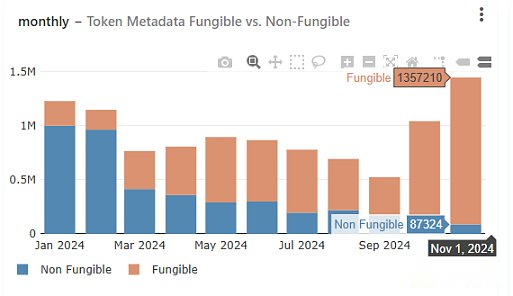
Metaplex Monthly Asset Minting Types
As of the day of writing (2024.11.30), Metaplex’s data also hit a record high, with the total types of minted assets exceeding 1.44 million in November.
What is more noteworthy is that 94% of the assets are homogeneous tokens, and only 6% of the assets are NFTs.In January this year, this data was still 18.6% to 81.4%, which means that from the perspective of business volume, Metaplex’s main business is already homogeneous token asset services, rather than NFT services.The minting and issuance of most homogeneous assets comes from the Meme craze.
3.3 Agreement Revenue
Agreement revenue refers to the payments Metaplex receives through the provision of the services.
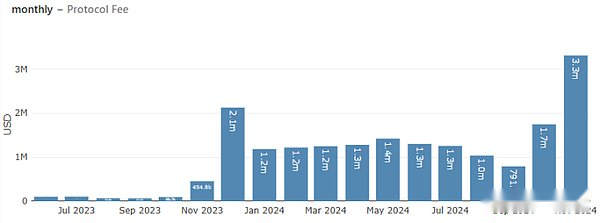
Metaplex Monthly Agreement Revenue
As of the day of writing (2024.11.30), Metaplex’s monthly agreement revenue reached US$3.3 million, also hitting a record high.
It should be noted that unlike many projects in the Web3 world that rely on token subsidies to drive product demand and spend project tokens for agreement revenue, Metaplex’s business income is quite organic and does not provide direct token subsidies. It is aTypically, a project with PMF (products fit with market demand) is implemented.
Through the data in this section, we can see:
-
As the underlying asset agreement, Metaplex directly benefits from Solana’s ecological development. Its core indicators have risen simultaneously with Solana’s core indicators, especially the agreement revenue.
-
Metaplex benefits from the activity of NFT and FT at the same time, and is not just a “NFT asset service agreement”. After Meme, if Solana can emerge more active tracks, such as Depin, Games, and RWA, Metaplex’s demand space will still beBeing further opened
-
Metaplex’s business needs are organic, and it can earn income without relying on token subsidies.
Next, let’s take a look at the team behind the Metaplex project and the situation of the project tokens.
Metaplex Team: Ecology close to Solana’s core circle OG

Stephen Hess
Metaplex is founder of Stephen Hess, who is also the chairman of Metaplex’s foundation, founded Metaplex Studios in November 2021.
As a graduate of Stanford Symbol Systems major, which focuses on the design of human-computer interaction systems, Stephen Hess was also one of Solana’s earliest employees (Solana had just started for a year when he joined), when Solana co-founder Raj invited himJoin Solana as the head of the product department.During his tenure, he participated in the development of Solana Stake Pools (Solana’s staking system), SPL governance system and Wormhole.He was also a team member of the first edition of the Solana NFT standard, which eventually evolved into Metaplex.
In January 2022, shortly after Metaplex was founded, Metaplex received a US$46 million strategic investment from institutions such as Multicoin, Jump and Alameda. If we use the 10.2% share of the strategic round of financing in the token allocation table, it can be estimated that Metaplex was at that time.This round of US$46 million in financial funds has a corresponding valuation of about US$450 million, which is quite high in the first-round first-round valuation even during the bull market.
Just as Metaplex is about to be established for a year, in November 2022, FTX collapsed due to huge financial bad debts.Although Metaplex’s financial situation was not directly affected by the FTX crash, Stephen Hess quickly announced a layoff decision on Twitter, ready for the upcoming Solana ecological depression at the time.Afterwards, it was proved that his approach was very correct at that time, and he had a clear understanding of the future, and did not have much of the Web3 team’s habit of spending money with big money in cost control.
According to Metaplex’s current Linkedin information, the team size is more than 10 people, and it is still quite streamlined. However, judging from its monthly project work report, this streamlined team has strong delivery capabilities and enterprising spirit in products.Iteration and new product development are very efficient.
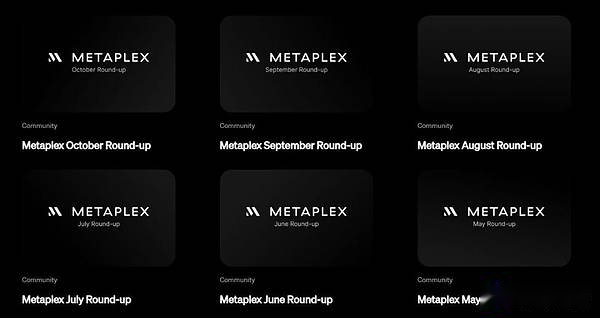
Metaplex’s monthly work report, source: official blog
Looking back at the work history and project development history of the founder of Metaplex, Metaplex basically meets the author’s comprehensive element concept for an excellent Web3 team:
-
Core members have educational, work skills and experience backgrounds that match the entrepreneurial program, and have no creditworthy deeds
-
Close to the core circle of the public chain ecosystem where you are located, the dialogue channels are smooth, and the product concept is recognized by the public chain ecological community.
-
Good product sense of smell (few detours), hard work, good results delivery
-
Cost control awareness, no money spent indiscriminately
-
Get the top VC investment in the industry and has excellent comprehensive business resources
In addition, on September 9, 2024, The Block disclosed that well-known institutions including Pantera Capital and ParaFi Capital purchased a large number of Metaplex (MPLX) tokens from Wave Digital Assets this year. These tokens were originally held by FTX, and the comprehensive cost of purchasing themIt is approximately $0.2-0.25 (with certain lock-up terms).
5. MPLX: Token utility and valuation level
5.1 Basic information of tokens
Metaplex’s protocol token is MPLX, with a total of 1 billion.
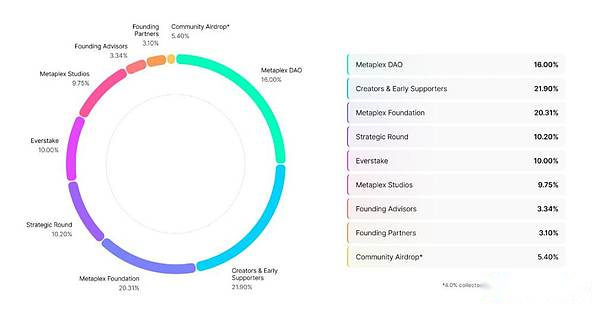
Image source: Project White Paper
The specific token allocation is as follows:
-
21.9% of creators and early supporters, of which 50% were issued in the form of airdrops within one year (the first airdrop starts September 22), and the remaining 50% were released monthly in the following year;
-
Metaplex DAO 16% , lock-free, distributed according to DAO proposals;
-
Metaplex Foundation 20.31%, no locking;
-
10.2% of the strategic round, 50% of which was issued one year after the first airdrop (September 22), and the remaining 50% were unlocked monthly in the following year;
-
Partner Everstake 10%, locked for two years (locked until September 2024), released linearly in one year, unlocking;
-
Metaplex Studios 9.75 %, locked for one year (locked until September 2023), released in two years linearly, unlocked;
-
Community airdrop 5.4%, released immediately;
-
Founding consultants account for 3.34%, locked for one year, released linearly in one year, and all have been unlocked;
-
Founding Partner 3.1%, locked for one year, released linearly in one year, and all unlocked.
According to the current official circulation data, the circulation rate of MPLX is 75.6%, and most of them are already in circulation, especially the share of investors, which has basically been circulated and has a small unlocking selling pressure.
The “uncirculated” part of the total volume mainly comes from shares controlled by Metaplex DAO and Metaplex Foundation, tokens held by the Treasury, and the ununlocked parts of Everstake and Metaplex Studios.
5.2 Token utility
Currently, the utility of MPLX is mainly governing voting.In addition, Metaplex announced in March 2024 that it will use 50% of the agreement revenue to repurchase (including historically accumulated agreement revenue), and the repurchased tokens will enter the treasury to develop the agreement ecosystem.
The formal start of the token repurchase began in June 24, and since then, 10,000 SOL has been used to repurchase the token MPLX every month, which has lasted for 5 months so far.
Due to the rapid increase in agreement revenue, Metaplex will increase the monthly amount of agreement repurchase from 10,000 SOL to 12,000 SOL next month.
In addition to governance and repurchase, the next scenario of MPLX will be activated by the Aura function mentioned above. After the subsequent Aura function is officially launched, MPLX is expected to become a pledged asset for Aura nodes, capturing the benefits generated by Aura.
5.3 Agreement Valuation
When measuring Metaplex’s valuation, we still use the comparative valuation method, but considering that Metaplex has no competition in Solana that can be used as a benchmark competitor, the author finally chose the same Solana ecosystem and also benefited from the Meme craze this yearRaydium, which also has a repurchase mechanism, has a reference for comparison valuation targets.

From the comparison of agreement revenue and agreement market value, Metaplex has a higher valuation.
But it should be emphasized that although the two projects have some commonalities, they are still two tracks in the same ecosystem, and their business positioning is very different. The above valuation comparison only has a certain reference value.
5.4 Potential drivers and risks
Overall, the advantages of Metaplex are obvious:
-
Located upstream of the asset service track, the ecological niche is in control of asset standards, and directly benefiting from the prosperity of the Solana ecosystem
-
Product PMF is fully verified, and can achieve positive cash flow without relying on token subsidies, and has a relatively clear business moat.
-
Based on existing business, actively expand the second growth curve
-
The team has good overall quality, is very close to the core ecological circle, is diligent and enterprising, and has a sense of cost control
-
The token has a repurchase mechanism, and the absolute market value of the project is also relatively low (circulating market value is 260 million +, FDV is 350 million +), and the plate is relatively light.
The potential upward driving force of Metaplex’s market value in the future is:
-
In addition to Meme, the Solana ecosystem has appeared other active tracks, further expanding the market for asset issuance, whether it is Depin, Games, RWA, or NFTs that have been cold for a long time.
-
Metaplex can launch larger trading platforms, such as Binance or Coinbase, to obtain a better liquidity premium (in terms of project quality and lower market value, the author thinks it is worth considering by the currency team, having real business needs and positive cash.The flowing projects are scarce in the market)
-
Directly increase the service charges.Currently, the fee base is relatively low, and the project has the ability to raise prices. Even if the price is 100%, the asset creation fee paid to Metaplex still accounts for an extremely low proportion to users, which can be ignored.
Of course, Metaplex also faces some potential risks and challenges, such as:
-
Solana Meme The craze fades, causing rapid decline in asset minting and business revenue to decline
-
Metaplex’s current revenue is collected in one lump sum according to the type of assets created. Those projects with relatively fixed asset types cannot bring continuous revenue to Metaplex for a long time.
Summarize
Unlike most investors’ impression that “Metaplex is an NFT asset agreement”, Metaplex is actually the basic agreement serving the entire Solana ecosystem assets and is a direct beneficiary of the Meme boom that has continued to this year.
If we continue to be optimistic about the Solana ecosystem in the future, then Metaplex, which occupies the “upstream niche” of “asset issuance and management”, is worthy of our long-term attention.








